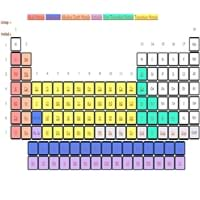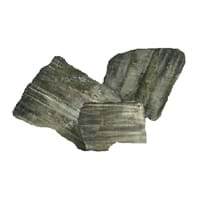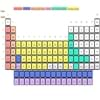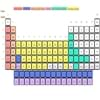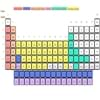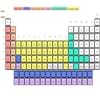Neptunium vs Lithium
Periodic Table
Symbol
Np
Li
Group Number
Not Available
1
17
Period Number
7
2
Block
f block
s block
Element Family
Actinide
Alkali
CAS Number
7439998
99+
7439932
99+
Space Group Name
Pnma
Im_ 3m
Space Group Number
62.00
11
229.00
1
Facts
Interesting Facts
Not Available
- Heat capacity of Lithium is very high.
- Lithium inflammable and highly explosive metal, hence it has to be stored properly.
Sources
Made by Bombarding Uranium with Neutrons, Ores of metals
Found in Minerals, Mining
History
Who Discovered
Edwin McMillan and Philip H. Abelson
Johan August Arfwedson
Discovery
In 1940
In 1817
Abundance
Abundance In Universe
Not Available
6 * 10-7 %
18
Abundance In Sun
~-9999 %
~0.00017 %
11
Abundance In Meteorites
Not Available
0.00 %
22
Abundance In Earth's Crust
Not Available
0.00 %
99+
Abundance In Oceans
Not Available
0.00 %
15
Abundance In Humans
Not Available
0.00 %
16
Uses
Uses & Benefits
- Currently known uses of Neptunium metal are limited to research purpose only.
- Neptunium’s isotope neptunium-237 is used as a neutron detectors.
- The main usage of Lithium is manufacturing rechargeable batteries for electronic equipment and gadgets.
- it is also used in manufacturing non-rechargeable batteries.
Industrial Uses
NA
Aerospace Industry, Electrical Industry, Electronic Industry
Medical Uses
NA
NA
Other Uses
Alloys, Nuclear Research, Research Purposes
Alloys
Biological Properties
Toxicity
Toxic
NA
Present in Human Body
No
Yes
In Blood
0.00 Blood/mg dm-3
37
0.00 Blood/mg dm-3
27
In Bone
0.00 p.p.m.
36
1.30 p.p.m.
17
Physical Properties
Melting Point
640.00 °C
99+
180.54 °C
99+
Boiling Point
3,902.00 °C
13
1,347.00 °C
99+
Appearance
Physical State
Solid
Solid
Color
Silver
Silvery White
Luster
Metallic
NA
Hardness
Mohs Hardness
Not Available
0.60
21
Brinell Hardness
Not Available
5.00 MPa
99+
Speed of Sound
Not Available
6,000.00 m/s
3
Optical Properties
Allotropes
No
No
α Allotropes
Not Available
Not Available
β Allotropes
Not Available
Not Available
γ Allotropes
Not Available
Not Available
Chemical Properties
Chemical Formula
Np
Li
Isotopes
Known Isotopes
20
19
8
30
Electronegativity
Pauling Electronegativity
1.36
29
0.98
99+
Sanderson Electronegativity
Not Available
0.89
26
Allred Rochow Electronegativity
1.22
26
0.97
38
Mulliken-Jaffe Electronegativity
Not Available
0.97
19
Allen Electronegativity
Not Available
0.91
99+
Electropositivity
Pauling Electropositivity
2.64
25
3.02
8
Ionization Energies
1st Energy Level
604.50 kJ/mol
99+
520.20 kJ/mol
99+
2nd Energy Level
1,128.00 kJ/mol
99+
7,298.10 kJ/mol
3
3rd Energy Level
1,997.00 kJ/mol
99+
11,815.00 kJ/mol
4
4th Energy Level
3,242.00 kJ/mol
99+
Not Available
Electrochemical Equivalent
1.77 g/amp-hr
39
0.26 g/amp-hr
99+
Electron Work Function
Not Available
2.90 eV
37
Other Chemical Properties
Ionization, Radioactive Isotopes, Radioactivity, Solubility
Corrosion, Flammable, Ionization, Radioactive Isotopes
Atomic Properties
Atomic Number
93
25
3
99+
Electron Configuration
[Rn] 5f4 6d1 7s2
[He] 2s1
Crystal Structure
Orthorhombic (ORTH)
Body Centered Cubic (BCC)
Crystal Lattice
ORTH-Crystal-Structure-of-Neptunium.jpg#100
BCC-Crystal-Structure-.jpg#100
Atom
Number of Protons
93
25
3
99+
Number of Neutrons
144
14
4
99+
Number of Electrons
93
25
3
99+
Radius of an Atom
Atomic Radius
155.00 pm
30
152.00 pm
31
Covalent Radius
190.00 pm
18
128.00 pm
99+
Van der Waals Radius
221.00 pm
22
182.00 pm
35
Atomic Weight
237.00 amu
22
6.94 amu
99+
Atomic Volume
11.62 cm3/mol
99+
13.10 cm3/mol
39
Adjacent Atomic Numbers
Valence Electron Potential
96.00 (-eV)
9
19.00 (-eV)
99+
Lattice Constant
666.30 pm
3
351.00 pm
99+
Lattice Angles
π/2, π/2, π/2
π/2, π/2, π/2
Lattice C/A Ratio
Not Available
Not Available
Mechanical Properties
Density
Density At Room Temperature
19.38 g/cm3
14
0.53 g/cm3
99+
Density When Liquid (at m.p.)
Not Available
0.51 g/cm3
99+
Tensile Strength
125.00 MPa
14
Not Available
Viscosity
Not Available
Not Available
Vapor Pressure
Vapor Pressure at 1000 K
Not Available
109.00 (Pa)
2
Vapor Pressure at 2000 K
0.11 (Pa)
17
Not Available
Elasticity properties
Shear Modulus
Not Available
4.20 GPa
99+
Bulk Modulus
Not Available
11.00 GPa
99+
Young's Modulus
Not Available
4.90 GPa
99+
Poisson Ratio
Not Available
Not Available
Other Mechanical Properties
Ductile
NA
Magnetic Properties
Magnetic Characteristics
Specific Gravity
20.25
6
0.53
99+
Magnetic Ordering
Paramagnetic
Paramagnetic
Electrical Properties
Electrical Property
Conductor
Conductor
Resistivity
1.22 nΩ·m
99+
92.80 nΩ·m
33
Electrical Conductivity
0.01 106/cm Ω
99+
0.11 106/cm Ω
19
Electron Affinity
Not Available
59.60 kJ/mol
16
Thermal Properties
Specific Heat
0.12 J/(kg K)
40
3.60 J/(kg K)
1
Molar Heat Capacity
29.46 J/mol·K
8
24.86 J/mol·K
99+
Thermal Conductivity
6.30 W/m·K
99+
84.80 W/m·K
20
Critical Temperature
Not Available
3,223.00 K
1
Thermal Expansion
Not Available
46.00 µm/(m·K)
7
Enthalpy
Enthalpy of Vaporization
Not Available
134.70 kJ/mol
99+
Enthalpy of Fusion
3.20 kJ/mol
99+
3.00 kJ/mol
99+
Enthalpy of Atomization
Not Available
160.70 kJ/mol
99+
Standard Molar Entropy
Not Available
29.10 J/mol.K
99+
|
||
|
||
|
